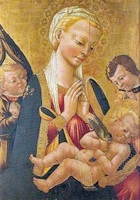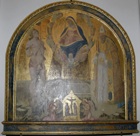Bicci di Lorenzo
The Florentine Bicci di Lorenzo trained in the workshop of his father, Lorenzo di Bicci, and was registered in the Guild of Painters at Florence in 1424. According to Giorgio Vasari, he painted a series of frescoes of “Uomini Famosi” (famous men) for the the so-called “old house” of the Medici family, but these do not survive.
Perugia
Sant’ Agnese Triptych (1430s)

-
✴The central pane depicts the mystic marriage of St Catherine of Alexandria:
-
•the Madonna and Child float on a cloud;
-
•St Catherine (with her wheel) stands to the right, accepting a ring from the baby Jesus;
-
•the titular of the nunnery, St Agnes stands to the left, holding the Lamb of God; and
-
•St Elizabeth of Hungary kneels below, crowned and carrying roses.
-
✴The side panels depict:
-
•SS Antony of Padua (with the flames of his eloquence in his hand), Louis of Toulouse and John the Evangelist in the right panel; and
-
•SS Herculanus, Constantius and Laurence (with his grill) in the left panel.
-
✴The panels in the upper register depict:
-
•the stigmatisation of St Francis on the left;
-
•the Annunciation, in the spandrels of the centre panel; and
-
•SS Jerome, Onuphrius (Onofrio, Humphrey) and Paul the Hermit (who kneels in front of his cave) on the right.
-
✴The predella panels depict:
-
•the risen Christ appearing to St Mary Magdalene and insisting “nole me tangere” (do not touch me);
-
•St Catherine rejecting the marriage proposal of the Emperor Maximin;
-
•St Elizabeth caring for the infirm; and
-
•the baptism of Christ.
-
✴The outer surfaces of the side panels depict:
-
•the obscure Beato Pavino del Bastone on the left; and
-
•St Ives (Sant’ Ivo di Bretagne) on the right. [St Ives, who died in 1303, was a Franciscan tertiary from Kermartin, Brittany. He trained as a lawyer and frequently defended people who were too poor to pay for legal advice. He was canonised 1347.]
Neri di Bicci
Neri di Bicci trained in the workshop of his father, Bicci di Lorenzo, and took over the family workshop when his father died. His journals from the years 1453-75, which are known as the Ricordanze, are still preserved in the library of the Uffizi Gallery.
Citta di Castello
Madonna and Child (15th century)

Spoleto
Madonna della Neve (ca. 1464)

The altarpiece depicts the Virgin with St Sebastian and Pope Liberius. Two angels at the bottom kneel before a Crucifix in a tabernacle. The iconography of the Madonna of the snow relates to the vision of Pope Liberius in which the Madonna caused snow to fall in August on the site in Rome on which she wanted him to build Santa Maria Maggiore. Pope Liberius is depicted pointing a plan of the church in the snow.



